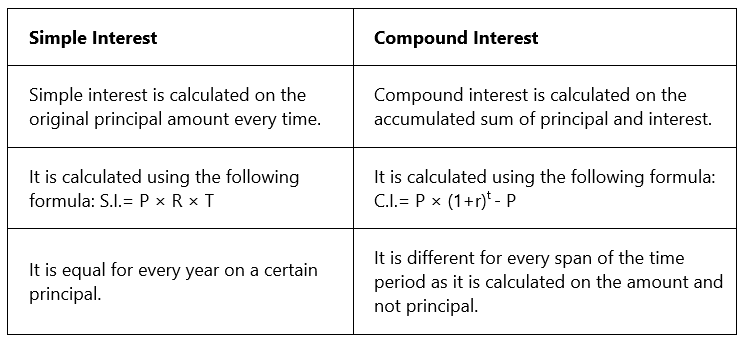Simple Interest | Mathematics for JAMB PDF Download
Simple interest is a method to calculate the amount of interest charged on a sum at a given rate and for a given period of time. In simple interest, the principal amount is always the same, unlike compound interest where we add the interest of previous years principal to calculate the interest of the next year.
This lesson, you will be introduced to the concept of borrowing money and the simple interest that is derived from borrowing. You will also be introduced to terms such as principal, amount, rate of interest, and time period. Through these terms, you can calculate simple interest using the simple interest formula.
What is Simple Interest?
Simple interest is a quick and easy method to calculate interest on the money, in the simple interest method interest always applies to the original principal amount, with the same rate of interest for every time cycle. When we invest our money in any bank, the bank provides us interest on our amount. The interest applied by the banks is of many types one of them is simple interest.
Now, before going deeper into the concept of simple interest, let's first understand what is the meaning of a loan. A loan is an amount that a person borrows from a bank or a financial authority to fulfill their needs. Loan examples include home loans, car loans, education loans, and personal loans. A loan amount is required to be returned by the person to the authorities on time with an extra amount, which is usually the interest you pay on the loan.
Simple Interest Formula
Simple interest is calculated with the following formula: S.I. = P × R × T, where P = Principal, R = Rate of Interest in % per annum, and T = Time, usually calculated as the number of years. The rate of interest is in percentage r% and is to be written as r/100.
- Principal: The principal is the amount that initially borrowed from the bank or invested. The principal is denoted by P.
- Rate: Rate is the rate of interest at which the principal amount is given to someone for a certain time, the rate of interest can be 5%, 10%, or 13%, etc. The rate of interest is denoted by R.
- Time: Time is the duration for which the principal amount is given to someone. Time is denoted by T.
- Amount: When a person takes a loan from a bank, he/she has to return the principal borrowed plus the interest amount, and this total returned is called Amount.
Amount = Principal + Simple Interest
A = P + S.I.
A = P + PRT
A = P(1 + RT)
Amount = Principal (P) + Simple Interest (S.l.)
Simple Interest
Example: Michael's father had borrowed $1,000 from the bank and the rate of interest was 5%. What would the simple interest be if the amount is borrowed for 1 year? Similarly, calculate the simple interest if the amount is borrowed for 2 years, 3 years, and 10 years?
Solution: Principal Amount = $1,000, Rate of Interest = 5% = 5/100. (Add a sentence here describing the given information in the question.)
Now, we can also prepare a table for the above question adding the amount to be returned after the given time period.
What Types of Loans use Simple Interest?
Most banks these days apply compound interest on loans because in this way banks get more money as interest from their customers, but this method is more complex and hard to explain to the customers. On the other hand, calculations become easy when banks apply simple interest methods. Simple interest is much useful when a customer wants a loan for a short period of time, for example, 1 month, 2 months, or 6 months.
When someone goes for a short-term loan using simple interest, the interest applies on a daily or weekly basis instead of a yearly basis. Consider that you borrowed $10,000 on simple interest at a 10% interest rate per year, so this 10% a year rate divide into a rate per day which is equal to 10/365 = 0.027%. So you have to pay $2.73 a day extra on $10,000.
Simple Interest vs Compound Interest
Simple interest and compound interest are two ways to calculate interest on a loan amount. It is believed that compound interest is more difficult to calculate than simple interest because of some basic differences in both. Let's understand the difference between simple interest and compound interest through the table given below:
Simple Interest: Tips and Tricks
- To find the time period, the day on which money is borrowed is not taken into account, but the day on which money has to be returned is counted.
- The rate of interest is the interest on every $100 for a fixed time period.
- Interest is always more in the case of compound interest as compared to simple interest.
- The formula or methods to calculate compound interest is derived from simple interest calculation methods.
- Rate of interest is always kept in fractions in the formula.
|
139 videos|82 docs|101 tests
|

















